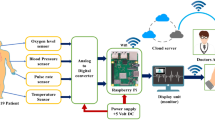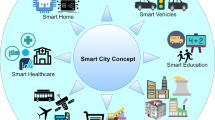Abstract
The healthcare industry is streamlining processes to offer more timely and effective services to all patients. Computerized software algorithm and smart devices can streamline the relation between users and doctors by providing more services inside the healthcare telemonitoring systems. This paper proposes a multi-sources framework to support advanced healthcare applications. The proposed framework named Multi Sources Healthcare Architecture (MSHA) considers multi-sources: sensors (ECG, SpO2 and Blood Pressure) and text-based inputs from wireless and pervasive devices of Wireless Body Area Network. The proposed framework is used to improve the healthcare scalability efficiency by enhancing the remote triaging and remote prioritization processes for the patients. The proposed framework is also used to provide intelligent services over telemonitoring healthcare services systems by using data fusion method and prioritization technique. As telemonitoring system consists of three tiers (Sensors/ sources, Base station and Server), the simulation of the MSHA algorithm in the base station is demonstrated in this paper. The achievement of a high level of accuracy in the prioritization and triaging patients remotely, is set to be our main goal. Meanwhile, the role of multi sources data fusion in the telemonitoring healthcare services systems has been demonstrated. In addition to that, we discuss how the proposed framework can be applied in a healthcare telemonitoring scenario. Simulation results, for different symptoms relate to different emergency levels of heart chronic diseases, demonstrate the superiority of our algorithm compared with conventional algorithms in terms of classify and prioritize the patients remotely.











Similar content being viewed by others
Abbreviations
- WBAN:
-
Wireless body area network
- MSHA:
-
Multi source healthcare architecture
- PC:
-
Priority code
- MI:
-
Medical institute
- GUI:
-
Graphical user interface
- DS:
-
Dempster-Shefer
- TP:
-
True positive
- TN:
-
True negative
- FP:
-
False positive
- FN:
-
False negative
References
Rasid, M. F. A., and Woodward, B., Bluetooth Telemedicine processor for multichannel biomedical signal transmission via mobile cellular networks. IEEE Trans. Inf. Technol. Biomed. 99(1):35–43, 2005.
Baig, M. M., and Gholamhosseini, H., Smart health monitoring systems: An overview of design and modeling. J. Med. Syst. 37:9898, 2013. doi:10.1007/s10916-012-9898-z.
Ullah, S., Higgins, H., Braem, B., Latre, B., Blondia, C., Moerman, I., and Kwak, K. S., A comprehensive survey of Wireless Body Area Networks: On PHY, MAC, and Network layers solutions. J. Med. Syst. 36(3):1065–1094, 2012. doi:10.1007/s10916-010-9571-3.
Lounis, A., Hadjidj, A., Bouabdallah, A., and Challal, Y., Secure and scalable cloud-based architecture for e-health wireless sensor networks. 2012 21st International Conference on Computer Communications and Networks (ICCCN) 1–7, 2012. doi:10.1109/ICCCN.2012.6289252.
Woodard, L., Sunday, D., and Magill, P., Medical surge capacity and capability: The CNA Corporation, 2004.
Bharathan, R., Aggarwal, R., and Darzi, A., Operating room of the future. Best Pract. Res. Clin. Obstet. Gynaecol. 27:311–322, 2012. doi:10.1016/j.bpobgyn.2012.11.003.
Rocha, A., Martins, A., Freire, J. C., et al., Innovations in health care services: The CAALYX system. Int. J. Med. Inform. 1–14, 2011. doi:10.1016/j.ijmedinf.2011.03.003.
Diallo, O., Rodrigues, J. J. P. C., and Sene, M., Real-time data management on wireless sensor networks: A survey. J. Netw. Comput. Appl. 35:1013–1021, 2012. doi:10.1016/j.jnca.2011.12.006.
Rezaee, A. A., Yaghmaee, M. H., Rahmani, A. M., and Mohajerzadeh, A. H., HOCA: healthcare aware optimized congestion avoidance and control protocol for wireless sensor networks. J. Netw. Comput. Appl. 1–13, 2013. doi:10.1016/j.jnca.2013.02.014.
Alemdar, H., and Ersoy, C., Wireless sensor networks for healthcare: A survey. Comput. Netw. 54:2688–2710, 2010. doi:10.1016/j.comnet.2010.05.003.
Kaiser Family Foundation, Trends in health care costs and spending health care, 2009.
Mazomenos, E. B., Biswas, D., Acharyya, A., et al., A low-complexity ECG feature extraction algorithm for mobile healthcare applications. IEEE Trans. Inform. Technol. Biomed. Publ. IEEE Eng. Med. Biol. Soc. 17:459–469, 2013. doi:10.1109/TITB.2012.2231312.
Sakanushi, K., Hieda, T., Shiraishi, T., et al., Electronic triage system for continuously monitoring casualties at disaster scenes. J. Ambient. Intell. Humaniz. Comput. 2012. doi:10.1007/s12652-012-0130-2.
Touati, F., and Tabish, R., U-healthcare system: State-of-the-art review and challenges. J. Med. Syst. 37:9949, 2013. doi:10.1007/s10916-013-9949-0.
Laskowski, M., Demianyk, B. C. P., Witt, J., et al., Agent-based modeling of the spread of influenza-like illness in an emergency department: A simulation study. IEEE Trans. Inform. Technol. Biomed. Publ. IEEE Eng. Med. Biol. Soc. 15:877–889, 2011. doi:10.1109/TITB.2011.2163414.
Houghton, A., and Gray, D., Making sense of the ECG: a hands-on guide. CRC Press, Boca Raton, 2008.
Hall, D., and Llinas, J. (Eds.), Multisensor data fusion. CRC Press, New York, 2001.
Gir, P. S., Data modeling for metrology and testing in measurement science. Forbes 205–254, 2009. doi:10.1007/978-0-8176-4804-6.
Khaleghi, B., Khamis, A., Karray, F. O., and Razavi, S. N., Multisensor data fusion: A review of the state-of-the-art. Inf. Fusion, 2011. doi:10.1016/j.inffus.2011.08.001.
Shnayder, V., Chen, B. R., Lorincz, K., Jones, T. R. F., and Welsh, M., Sensor networks for medical care. In: SenSys (Vol. 5, pp. 314–314), 2005.
Ahn, J., Heo, J., Lim, S., Seo, J., and Kim, W., A study of healthcare system for patient location data based on lbs. In: Consumer Electronics, 2008. ICCE 2008. Digest of Technical Papers. International Conference on (pp. 1–2). IEEE, 2008.
Gao, T., Massey, T., Selavo, L., Crawford, D., Chen, B. R., Lorincz, K., … and Welsh, M., The advanced health and disaster aid network: A light-weight wireless medical system for triage. IEEE Trans. Biomed. Circ. Syst. 1(3):203–216, 2007.
Cavouras, D., Georgiadis, P., Ninos, K., and Nomicos, C., Electromagnetic signals monitoring by smartphones and 3G wireless networks. European Geosciences Union General Assembly, 2008.
Yu, X., and Ganz, A., Scalable patients tracking framework for mass casualty incidents. In: Engineering in Medicine and Biology Society, EMBC, 2011 Annual International Conference of the IEEE (pp. 860–863). IEEE, 2008.
Shih, D.-H., Chiang, H.-S., Lin, B., and Lin, S.-B., An embedded mobile ECG reasoning system for elderly patients. IEEE Trans. Inform. Technol. Biomed. Publ. IEEE Eng. Med. Biol. Soc. 14:854–865, 2010. doi:10.1109/TITB.2009.2021065.
Kateretse, C., Lee, G.-W., and Huh, E.-N., A practical traffic scheduling scheme for differentiated services of healthcare systems on wireless sensor networks. Wirel. Pers. Commun. 2012. doi:10.1007/s11277-012-0851-8.
Georgopoulos, V. C., and Stylios, C. D., Fuzziness and medicine: Philosophical reflections and application systems in health care. 8th IFAC Symposium on Biological and Medical Systems 302:415–436, 2013. doi:10.1007/978-3-642-36527-0.
Lee, H., Park, K., Lee, B., Choi, J., and Elmasri, R., Issues in data fusion for healthcare monitoring. In: Proceedings of the 1st international conference on PErvasive Technologies Related to Assistive Environments (p. 3). ACM, 2008.
Sung, W.-T., Multi-sensors data fusion system for wireless sensors networks of factory monitoring via BPN technology. Expert Syst. Appl. 37:2124–2131, 2010. doi:10.1016/j.eswa.2009.07.062.
Polikar, R., Topalis, A., Parikh, D., et al., An ensemble based data fusion approach for early diagnosis of Alzheimer’s disease. Inf. Fusion 9:83–95, 2008. doi:10.1016/j.inffus.2006.09.003.
Venkatesh, V., and Park, T., Healthcare data fusion and presentation using Service- Oriented Architecture (SOA) orchestration mechanism. Scenario 4–8, 2011.
Medjahed, H., Istrate, D., Boudy, J., et al., A pervasive multi-sensor data fusion for smart home healthcare monitoring. 1466–1473, 2011.
Pantelopoulos, A., and Bourbakis, N. G., Prognosis-a wearable health-monitoring system for people at risk: Methodology and modeling. IEEE Trans. Inform. Technol. Biomed. Publ. IEEE Eng. Med. Biol. Soc. 14:613–621, 2010. doi:10.1109/TITB.2010.2040085.
Luo, R. C., Chang, C. C., and Lai, C. C., Multisensor fusion and integration: Theories, applications, and its perspectives. IEEE Sensors J. 11:3122–3138, 2011. doi:10.1109/JSEN.2011.2166383.
Kaftandjian, V., Zhu, Y. M., Dupuis, O., and Babot, D., The combined use of the evidence theory and fuzzy logic for improving multimodal nondestructive testing systems. IEEE Trans. Instrum. Meas. 54:1968–1977, 2005. doi:10.1109/TIM.2005.854255.
Latré, B., Braem, B., Moerman, I., Blondia, C., and Demeester, P., A survey on wireless body area networks. Wirel. Netw 17(1):1–18, 2010. doi:10.1007/s11276-010-0252-4.
Yan, H., Huo, H., Xu, Y., and Gidlund, M., Wireless sensor network based E-health system - implementation and experimental results. IEEE Trans. Consum. Electron. 56(4):2288–2295, 2010. doi:10.1109/TCE.2010.5681102.
Shapira, J., Electromagnetic compatibility (EMC) for system engineers, n.d.
Wald, L., Some terms of reference in data fusion. IEEE Trans. Geosci. Remote Sens. 37(3):1190–1193, 1999.
Christensen, D., Jensen, N. M., Maaløe, R., et al., Nurse-administered early warning score system can be used for emergency department triage. Dan. Med. Bull. 58:A4221, 2011.
Christensen, D., Jensen, N. M., Maaløe, R., et al., Low compliance with a validated system for emergency department triage. Dan. Med. Bull. 58:A4294, 2011.
Klasnja, P., and Pratt, W., Healthcare in the pocket: Mapping the space of mobile-phone health interventions. J. Biomed. Inform. 45:184–198, 2012. doi:10.1016/j.jbi.2011.08.017.
Calhoun, B. H., Lach, J., Stankovic, J., Wentzloff, D. D., Whitehouse, K., Barth, A. T., … and Zhang, Y., Body sensor networks: A holistic approach from silicon to users. Proc. IEEE 100(1):91–106, 2012.
Joseph, T., ECG in emergency medicine and acute care. Emerg. Med. Australas. 18(2):203, 2006.
Eren, A., Subasi, A., and Coskun, O., A decision support system for telemedicine through the mobile telecommunications platform. J. Med. Syst. 32(1):31–35, 2007. doi:10.1007/s10916-007-9104-x.
Golberger, A., Amaral, L., Glass, L., Hausdorff, J. M., Ivanov, P. C., Mark, R. G., … and Stenley, H. E., PhysioBank, PhysioToolkit, and PhysioNet: Component of a new research resource for complex physiologic signals. Circulation 101:23, 2000.
Lo, B., Atallah, L., Aziz, O., El ElHew, M., Darzi, A., and Yang, G. Z., Real-time pervasive monitoring for postoperative care. In: 4th international workshop on wearable and implantable body sensor networks (BSN 2007) (pp. 122–127). Springer Berlin Heidelberg, 2007.
American Heart Association, Heart and circulatory system diseases http://www.heart.org/HEARTORG/Conditions/HighBloodPressure/High-Blood-Pressure_UCM_002020_SubHomePage.jsp, 2014. Accessed 12 February 2014.
Powers, D. M., Evaluation: From precision, recall and F-measure to ROC, informedness, markedness & correlation. J. Mach. Learn. Technol. 2(1):37–63, 2011.
Scheffler, M., and Hirt, E., Wearable devices for telemedicine applications. J. Telemed. Telecare 11(suppl 1):11–14, 2005.
Kalyani, K. L., Rajeswari, N., and Yasaswini, K., WBAN : A persuasive area in ubiquitous health care. Int. J. Comput. Sci. Inf. Technol. 5(1):60–63, 2014.
Ambulatory, N., Care, M., Cdc, T., et al., Medscape Physician Compensation Report: 2011 Results, 2014. http://www.medscape.com/viewarticle/462656. Accessed 12 February 2014.
Xiong, W., Bair, A., Sandrock, C., Wang, S., Siddiqui, J., and Hupert, N., Implementing telemedicine in medical emergency response: Concept of operation for a regional telemedicine hub. J. Med. Syst. 36(3):1651–1660, 2012. doi:10.1007/s10916-010-9626-5.
Don, S., Chung, D., Choi, E., and Min, D., An awareness approach to analyze ECG streaming data. J. Med. Syst. 37(2):9901, 2013. doi:10.1007/s10916-012-9901-8.
Li, S.-H., Cheng, K.-A., Lu, W.-H., and Lin, T.-C., Developing an active emergency medical service system based on WiMAX technology. J. Med. Syst. 36(5):3177–3193, 2012. doi:10.1007/s10916-011-9809-8.
Acknowledgments
The authors get a patent for the framework of this study. The completed draft has been filed to the Malaysian Patent Office and below is the details:
• Filing No. : PI2013701135, Filing Date: 28/6/2013
• Title : A System and Method for Providing Services in Telemedicine Application
Conflict of Interest
The authors declare that they have no competing interests.
Authors’ Contributions
All authors contributed equally to this work.
Author information
Authors and Affiliations
Corresponding author
Additional information
This article is part of the Topical Collection on Systems-Level Quality Improvement
Rights and permissions
About this article
Cite this article
Salman, O.H., Rasid, M.F.A., Saripan, M.I. et al. Multi-Sources Data Fusion Framework for Remote Triage Prioritization in Telehealth. J Med Syst 38, 103 (2014). https://doi.org/10.1007/s10916-014-0103-4
Received:
Accepted:
Published:
DOI: https://doi.org/10.1007/s10916-014-0103-4




